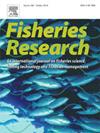Analysis and prediction of fishing capacity of marine fishing vessels based on generalized additive models
IF 2.2
2区 农林科学
Q2 FISHERIES
引用次数: 0
Abstract
This study used Generalized Additive Models (GAM) to analyze single-vessel catch volume using the 2018 operational survey data of fishing vessels from three provinces in the South China Sea. The results of our analysis showed that PCA1 (the factor after dimension reduction of total tonnage and length of the vessel), PCA2 (the factor after dimension reduction of type width and type depth), power, age, and operation time (OT) all had a significant effect on catch volume. By comparing the performance of different GAM models, it was found that PCA1, PCA2, power, age, and operation time provided the highest explanatory power, explaining 63.52 % of the cumulative deviation of the catch volume. Cross-validation analysis showed that when the dataset was randomly divided into a training set and a test set with a ratio of 0.67:0.33, the fitted coefficient of determination was approximately 0.76, indicating good predictive performance of the model. This study proposes an objective approach to quantify single-vessel fishing capacity and assessing single-vessel catch volume, explore the scientific value inherent in fishing data; it also provides a reference for the intelligent application of fishing data.
求助全文
约1分钟内获得全文
求助全文
来源期刊

Fisheries Research
农林科学-渔业
CiteScore
4.50
自引率
16.70%
发文量
294
审稿时长
15 weeks
期刊介绍:
This journal provides an international forum for the publication of papers in the areas of fisheries science, fishing technology, fisheries management and relevant socio-economics. The scope covers fisheries in salt, brackish and freshwater systems, and all aspects of associated ecology, environmental aspects of fisheries, and economics. Both theoretical and practical papers are acceptable, including laboratory and field experimental studies relevant to fisheries. Papers on the conservation of exploitable living resources are welcome. Review and Viewpoint articles are also published. As the specified areas inevitably impinge on and interrelate with each other, the approach of the journal is multidisciplinary, and authors are encouraged to emphasise the relevance of their own work to that of other disciplines. The journal is intended for fisheries scientists, biological oceanographers, gear technologists, economists, managers, administrators, policy makers and legislators.
 求助内容:
求助内容: 应助结果提醒方式:
应助结果提醒方式:


